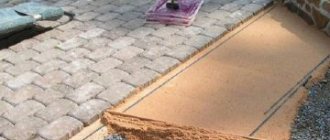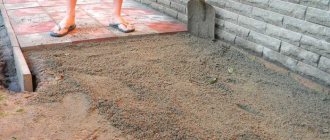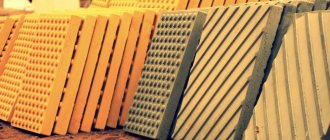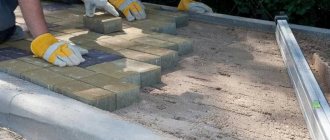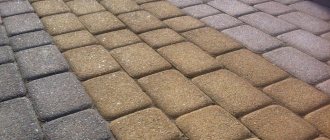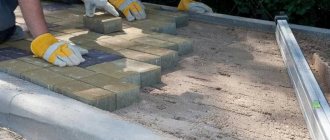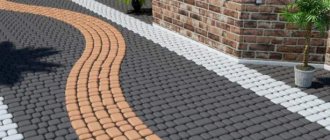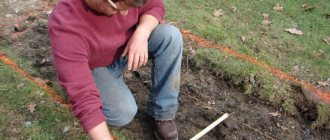Let's figure out what the differences are between materials that are similar at first glance, such as paving stones and paving slabs. We compare how paving stones and paving slabs are laid, and which material is better to choose in each specific case. After you learn about all the advantages and disadvantages of tiles and paving stones, you will be able to make a rational choice and make the territory of your personal plot not only comfortable, but also very beautiful.
Hardened clinker paving stones Source terracot.ua
Paving stones
Paving stones are small pieces of turned stone. Intended for paving roads, local areas, courtyards of private buildings. It differs from paving slabs in the same thickness, length and width.
The main material configurations are cubes and bricks. The paving stones are based on solid rock. It could be:
- Basalt
- Granite
The structure of these stones allows the paving stones to withstand heavy loads for many years. Over time, the stone is polished and looks even more interesting than immediately after installation.
A little earlier, when making paving stones, the stones were split into approximately equal-sized fragments and then the pavement was laid from them on the road. This manufacturing option was called chipped. This surface is not ideally even, however, it looks quite interesting. It is these paving stones that tourists visiting ancient European cities pay attention to.
Crushed paving stones on the streets of ancient cities Source stroyday.ru
Nowadays sawn stone is mainly used. This technology makes it possible to give all the bars almost the same size. Due to the fact that all sides of the stone blocks are processed, the material is called full-sawn. Laying such paving stones is simpler, and walking on a flat sidewalk or path is much more convenient. Now it is quite popular, despite the high cost.
Smooth, fully sawn paving stones Source stela-memorial.ru
The third option for paving stones is split-sawn. Its production takes place in two stages:
- The stone blank is sawn into pieces of approximately the same thickness.
- The sawn pieces are split to create paving stones of equal size.
A sidewalk path laid out in a combined way, combining split-sawn and full-sawn paving stones, looks especially advantageous.
Sidewalks and paths look very advantageous, where full-sawn and split-sawn paving stones are successfully combined.
Chip-sawn paving stones Source atex-m.ru
Clinker paving stones began to be produced in Germany in the 19th century. Bars of the same shape and size were made from natural slate clay, which were subsequently fired in industrial kilns at high temperatures. The viability of such production led to an increase in its volumes. 150-year operation for this type of paving stones is not the limit.
Cofigcaption belt production allows us to produce an alternative type of paving stones - concrete. True, calling such material that way is not entirely correct. In addition to concrete, its composition includes numerous polymer additives that provide it with:
Source decorator.shop
- Wear resistance
- Immunity to aggressive external environment
- Possibility of painting in almost any color
Such paving stones create enormous opportunities for the flight of designer imagination. The ability to produce paving stones of any shape provides the master with the opportunity to easily round off paths, transitions and curved areas. In this case, labor-intensive pruning is not required.
Option for beautiful laying of paving stones Source plitkalobnya.ru
Advantages
Many people prefer paving stones due to its obvious advantages such as:
- Reliability and strength - these indicators far exceed the properties of concrete or asphalt
- Longevity - the area paved with paving stones will look great even after 300 years
- The presence of a sand cushion - drainage does not allow water to linger on the surface
- Withstands intense loads
- Excellent aesthetic properties
Flaws
The disadvantages of paving stones include:
- High cost
- The need for careful adherence to installation technology
- Noise from the coating
- Inconvenience of movement for owners of stiletto heels
- Wet paving stones are very slippery
Vibrocast and vibropressed FEM
On the market you can find such types of paving stones as vibropressed and vibrocast. They are produced using different technologies and have distinctive properties.
The first type is created on the basis of semi-dry concrete mixtures, which are compacted using a vibration press: during the production process, a special vibrating table affects the mixture. After this, the finished products are placed in chambers and undergo a hardening stage. The products are two-layer and consist of the following parts:
- Cladding layer.
- Base layer.
Crushed stone of different fractions (from 0.63 to 10 mm) is used as a base, which is combined with sand, cement and chemical fillers. Such structures are resistant to heavy loads. The facing layer is made of fine-grained crushed stone, which is frost-resistant and moisture-resistant. If the production technology is followed without deviations, the two layers acquire a uniform structure and high strength properties.
Vibro-cast paving stones are made using a liquid mixture of concrete, which is processed with a vibrating table and pressed by its own weight, after which it is distributed into a mold. This technology eliminates the need to use large crushed stone, since it will accumulate on the front side, worsening the aesthetics of the tile.
For production, fine-grained crushed stone with a fraction of 0-5 mm and sand are used. This negatively affects the strength properties, and can also lead to a violation of the proportions of the geometry due to the influx of concrete mixture.
Bright colors of paving slabs
The popularity of paving slabs is largely due to the variety of their shapes and colors. It is somewhat thinner than its “big sister” - paving stones. But it differs favorably from her in its elegance.
Entrance steps made of paving slabs Source budnet.pl
The material is obtained artificially by pouring concrete into molds or firing a clay composition. Thus, the resulting material is divided into two types:
- Concrete tiles
- Clinker tiles
Given the more complex manufacturing, the second option is slightly more expensive.
See also: Catalog of companies that specialize in landscaping work on sites.
Advantages
The main advantage of paving slabs is their chic aesthetic qualities. The material can be selected to match the color of the surrounding buildings. In addition, it is not at all difficult to lay out unique designs or geometric patterns on sidewalks or paths.
Figured laying of paving slabs Source pinterest.com
Also obvious advantages include:
- Simple masonry
- Resistance to the influence of aggressive external environment
- Possibility of replacing individual tiles
- Convenience for pedestrian traffic
- Low cost of material
Flaws
The only disadvantage of paving slabs is their shorter service life compared to paving stones.
Having familiarized yourself with the advantages and disadvantages of both materials, you can proceed to choosing the one that is best suited for you and its installation. After carefully reading the instructions, you can lay both paving stones and paving slabs in a high-quality manner yourself. True, the technology for laying paving stones is more complex and requires at least minimal skills in construction work.
Polymer-sand tiles - easy maintenance plus durability
Another name for polymer-sand paving slabs is plastic. It is made from sand with the addition of adhesive polymers and dyes, without the use of cement.
Polymer-sand tiles.
The technical parameters of polymer-sand paving stones are quite good:
- Wear resistance is above average. Unlike concrete, it does not form chips at the edges and is highly resistant to mechanical damage.
- Water absorption is zero. This is an important indicator that provides materials for external use with durability and the ability to operate at sub-zero temperatures.
- Easy care. The polymer-sand surface is easy to clean using conventional wet care products.
A wide variety of colors, shapes, and reliefs of polymer-sand tiles allows homeowners to decorate their local area in an original way, making it different from neighboring areas.
Laying paving stones yourself
The excellent decorative and functional qualities of paving stones allow you to create an individual design for your garden plot. Laying paving stones in the following areas can be considered the most justified:
- Garden paths - paving stones look especially impressive near the swings, sculptures, garden benches, gazebos, pools or alpine slides available on the site.
- For framing flower beds located in the middle of the lawn.
For finishing garden and park stairs in areas with difficult terrain. Source manesu.com
- For decorating the front of the house, garage or any other visible area where hard surface is replaced with pavers for a great visual effect.
Calculation of paving area
Before you begin to calculate the paving area, you need to draw a site plan, marking on it the places where you plan to lay paving stones. There are 2 ways to do this:
- The plan is drawn on A3 graph paper, at a scale convenient for you. It marks the areas where there will be paving stones and calculates their area. If the shape of the plots is complex, they are divided into simpler fragments or the total area is calculated by counting the filled squares.
- To calculate the required area, you can use free programs from the Internet: 3D Home Architect Design Suite Delux, Garden Planner, SketchUp.
How paving stones are laid out
Numerous paving options are now available. However, if you are not a specialist, you need to choose simpler schemes. The following examples can be considered as an example:
“Seam to seam” - paving stones are laid out with the seams completely matching Source remontkvartiri.su
How to choose paving stones?
To purchase quality material, you need to pay attention to the following details:
- Reputation of the construction base.
- Too low a price indicates low-quality material.
- When two elements of paving stones strike, a loud knock should be heard.
- There can be no voids inside.
- Uneven coloring of vibro-cast paving stones indicates low quality.
Paving stone size
Depending on the expected load on the surface, products of different thicknesses are selected:
- 4 cm
– on alleys, squares, pedestrian roads; - 4-7 cm
– in areas where passenger vehicles travel; - 7 cm
– suitable for any area.
The most popular sizes of paving stones:
- 5x5x5 cm
. Square paving stones are used for paving park paths, roadways, and parking lots. - 20x10x8 cm
. This type is universal and suitable for roads with increased mechanical load. - 20x10x4 cm
. It is used on sidewalks, alleys and avenues. - 20x10x6 cm
. It is used on roads, creating good traction with car wheels in any weather.
Stages of work execution
These are the simplest ways to lay paving stones. Once you have decided which one is best for you, you can proceed to installation. It is performed in several stages:
- Mark the laying area using wooden pegs and cords. Do not forget to take into account the slope of the water flow and the height (so that later the paving stones do not interfere with opening the door of the house or garage).
- Select soil to the depth of the paving stones and level the surface (in most cases this is 30-35 cm).
- Lay out a 15-centimeter layer of crushed stone and lay geotextiles in an even layer.
- Lay out a 10 cm layer of sand.
- The mixture on which the paving stones will be laid. As an option, you can use a liquid solution of sand and cement 3:1. The layer is about 3 cm.
- Each laid out layer is carefully compacted; it is advisable to use a vibropress.
- Laying paving stones.
- Fill the resulting seams with fine sand.
- Wet the surface.
You can use the laid paving stones within a day after laying. Source design-solar.com
DIY paving stones
To save money, you can make the tiles yourself. Do-it-yourself paving stones are made as follows:
- Mix cement with sand.
- Add the required amount of water until it reaches the consistency of “thick sour cream.”
- For better strength, add a little fine gravel to the resulting mixture.
- Add pigment (optional).
- Fill out the forms only 1/3 full.
- To prevent paving stones from bursting after installing paths or platforms, place a reinforcing mesh on top.
- Fill the form to the edge and compact it.
- If you want to end up with a smooth surface, pour a thin layer of cement onto the “wet” mixture and smooth it out.
- Over the next three days, wet the surface with a spray. This will prevent cracks from appearing.
Paving slabs in the garden area
Paving a summer cottage with paving slabs has recently become increasingly popular. This is facilitated by the lower cost of the material compared to paving stones and the special design of paving slabs, which makes working with them easier.
Initially, you need to decide on diagrams, patterns and drawings, this will allow you to visualize the project and correctly calculate the required material. Here you need to take into account the shape of the tiles and the desired layout design. It is best for novice craftsmen to choose standard 100x200 mm paving slabs, which allow you to perform almost any installation of material.
Clinker tiles - respectability plus durability
Clinker varieties of paving slabs are the hardest of all known on the market. They are made from clinker - ceramics made from special types of clay, the high strength of which is achieved by firing at temperatures above 1200 degrees C. This is a fairly expensive material. Noble appearance, impact resistance, low water absorption are the main advantages of the product. Clinker has an anti-slip effect, which ensures strong adhesion of shoes to the surface even in rain.
Clinker tiles.
Shapes, colors and textures of clinker tiles
Luminous pavement tiles
If you consider yourself to be an extravagant person and love creativity in everything, you will undoubtedly be interested in luminous paving material, the so-called lyubmobeton. Its glow-in-the-dark time is 8-10 hours. On sunny days, it is “charged” with the energy of sunlight (electric lighting is also suitable for this) and after dark it begins to glow.
This material will turn your site into an extraordinary, exclusive corner that all guests of your home will admire. Such tiles resemble a lunar path that everyone would like to walk along. The material produces the greatest effect in the first hours after dark.
Production of hyperpressed tiles
Hyperpressed tiles are made using the semi-dry pressing method. It is also made from cement and marbled limestone with the addition of minerals and pigments.
Such production raw materials are placed in molds and subjected to a press with a pressure of up to 20 MPa. Then, the resulting products are exposed to high temperatures in steaming chambers with a special temperature regime. After which, the resulting products are dried in special rooms with a certain temperature and humidity regime. The process of such production is carefully regulated and must correspond to the developed technology in all its details. Hyper-pressed tiles are used not only for paving sidewalks, but also for arranging facades.
Paving stones or tiles on private property
Paving stones or tiles in the courtyard of a private house are an almost irreplaceable element of landscape design. And here, again, everything directly depends on personal preferences. You can cover the entire yard with tiles, leaving no space for greenery. Or, on the contrary, you can successfully combine flower beds, a lawn and paths paved with paving stones or tiles. This could be a path to the central and back entrance, garage or outbuildings. In any case, tiles in a private yard are a must.
This installation will allow you to walk on clean tiles in inclement weather and not bring dirt from the street into the house. For the same reasons, laying tiles in the country is also indispensable.
Tile laying options
The main advantage of this material is that it can be laid in various ways: herringbone, diamond, star, checkerboard, chaotic. It depends on the size and shape, color scheme and imagination. Paving stones have fewer solutions from this point of view: the material is laid out evenly or in patterns, matching the shade.
Regardless of what was chosen for paving paths or recreation areas, the products are laid on a pre-prepared base. It can be sand or concrete, the latter will last longer. It is also worth making a drainage layer of crushed stone to remove excess moisture.
Do-it-yourself installation or professional services
Even though you already know how to lay paving slabs, this does not mean that you can handle the work yourself. In any case, independent work will not only take up your personal time, but also leave the risk that you will not be able to complete the work at the level of professionals.
Landscaping work with high-quality paving slabs will visually expand the space of the land plot and make your yard pleasant for both owners and guests. Just tell the craftsmen what kind of layout of paving slabs or paving stones you are interested in, and calmly go about your business, and let the professionals do the laying of the tiles.
A little more attention!
Write in the comments what you think - without experience, will you be able to lay paving stones yourself and with high quality, or should everyone mind their own business?
Differences in composition
When determining which paving slabs are better, in addition to the production technology, the composition must be considered. Based on the basic components, 5 main varieties are distinguished. The table provides descriptive characteristics of each type.
| Tile type | Basic composition | Peculiarities |
| Concrete | The composition includes cement binder and mineral filler made of sand and fine gravel or crushed stone. | Such tiles are most often used in the urban sector, where there is a high level of traffic. |
| Clinker | The environmentally friendly material is made from clay, which is exposed to high temperatures. | Additional dyes are practically not used due to the original results after firing. The surface of the products is rough, which prevents slipping in winter. |
| Rubber | It is often made from recycled recycled materials (the main resource is tires) with the addition of polyurethane and technical filler. | This type of covering is installed in play areas for children, on sports grounds, around decorative ponds and swimming pools. The springy material is anti-slip and softens impacts when falling, regardless of the weather. |
| Plastic | The composition includes sand and polymer binder with dyes. The working mass is sintered at a temperature of about +260 degrees Celsius. | It is believed that these are the best paving slabs, as they last longer than analogues due to zero abrasion, resistance to high mechanical loads, and crack resistance. |
| Granite | Production is carried out from natural mineral chips at high temperatures. | The material is distinguished by its natural inertness to aggressive operating conditions. |
Concrete paving slabs are in greatest demand. This is justified by a wide range, good performance characteristics, versatility in application (including design ideas) and affordable cost. Let us consider in more detail the methods of manufacturing materials for the design of pedestrian zones and areas for active recreation.


